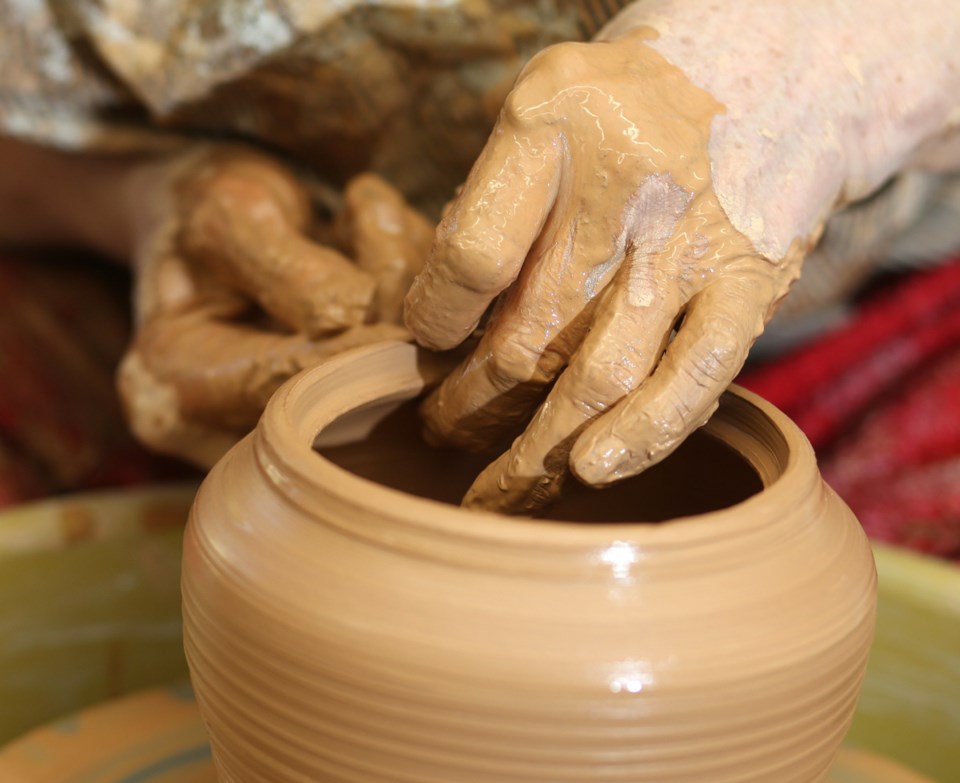It was 33 years ago when I last saw Glenn Lewis. As word reached me that he had arrived as senior artist-in-residence at Camosun College for the month of January, I went right over. Lewis is unchanged, except for lots of greying hair. Even at 78, he is as irrepressible and provocative as ever.
In the ceramics studio at Camosun, he was wearing a ball cap and an apron spattered with clay. Our interview was from time to time diverted as he stepped over to help students at their potters’ wheels. John Boehme, the fine-arts instructor, proposed Lewis for this residency because Lewis is a renowned potter and always incorporates ceramics in his a wide-open performance practice. Camosun is the only school on the south Island that teaches both ceramics and performance.
Born in Chemainus in 1935, Lewis grew up here on Vancouver Street and went to Sir James Douglas School. His father served in the Navy during wartime and Lewis recalled the blackout curtains and the bomb shelter at the end of the street. He later studied painting at the Vancouver School of Art, but he couldn’t see himself becoming an abstract expressionist. He had taken a few lessons in pottery, and a suggestion by his friend John Reeve soon changed his life.
Reeve worked with Bernard Leach, author of A Potter’s Book, which was then every potter’s studio bible. Reeve advised Lewis to apply to work at the Leach Pottery in St. Ives, Cornwall, and upon acceptance Lewis apprenticed there from 1961 to 1963. British pottery had been almost extinguished by the industrial revolution and Leach, who grew up in Japan, was inspired by William Morris. He felt that it should be revived. Working with his friend Shoji Hamada, they simultaneously trained a generation of craft workers who would regenerate ceramics in the West, and fostered the “mingei” movement, the Japanese folk craft revival.
Lewis worked making the Leach standard wares at St. Ives, but upon returning to ��ѻ��ý he cut loose. In 1970 he created a mural for the Canadian pavilion at Expo 70 in Osaka, Japan. It involved 176 tiles, was about three by seven metres in size, and involved unmistakably phallic “salt shakers” sticking out. Rejected for the pavilion, it was bought by the Vancouver Art Gallery, where it was kept in its basement for 40 years. It was first exhibited in 2010 at Presentation House in North Vancouver. Ahead of his time, you might say.
Lewis and his mates were part of Marshall McLuhan’s global village, and formed Vancouver’s Intermedia collective in the late ’60s, creating the first experiments in artists’ video, correspondence and performance art. With Michael Morris (who grew up in Victoria) and Eric Metcalfe (who graduated from UVic), Lewis was one of the owners of The Western Front, Vancouver’s seminal artist-run gallery. Founded in 1975, The Front continues to this day.
In the early 1970s, Lewis travelled the world with photographer Taki Bluesinger documenting gardens. He envisioned gardens as symbolic landscapes, replete with living sculpture and storytelling. This resulted in his exhibition and book, Bewilderness, and it was a revelation to me. Along with Italy’s Boboli Gardens and India’s Taj Mahal, the wind-blown trees on the waterfront of Beacon Hill Park were included. It was about then that I lost track of him, for Lewis moved to Sechelt and began a nursery dedicated to scented plants.
Just a few years ago, Lewis returned to Vancouver and he became a visiting artist with the ceramics department at Capilano University. Sadly, after 20 years of constructive and creative teaching, Capilano has recently announced it is closing its fine-arts program entirely — to make way for a school of business. You can guess what Lewis thinks of that. It was in reaction to this loss that Boehme invited him to the residency at Camosun.
Lewis has a busy year ahead. In February he will display porcelain bowls and photographs of East Hastings Street at a gallery in Vancouver. In March he’s off to Amsterdam where not only his pots and drawings will be on display, but he has been asked to choreograph a “water ballet” with swimmers in shark-fin bathing caps. And then he’s off to Japan for two three-month residencies, at both Shigaraki and Bizen, which are famous ancient kiln sites.
I stand in awe of this man’s energy and openness. He’s certainly an inspiration to the students in the ceramics studio at Camosun College.



